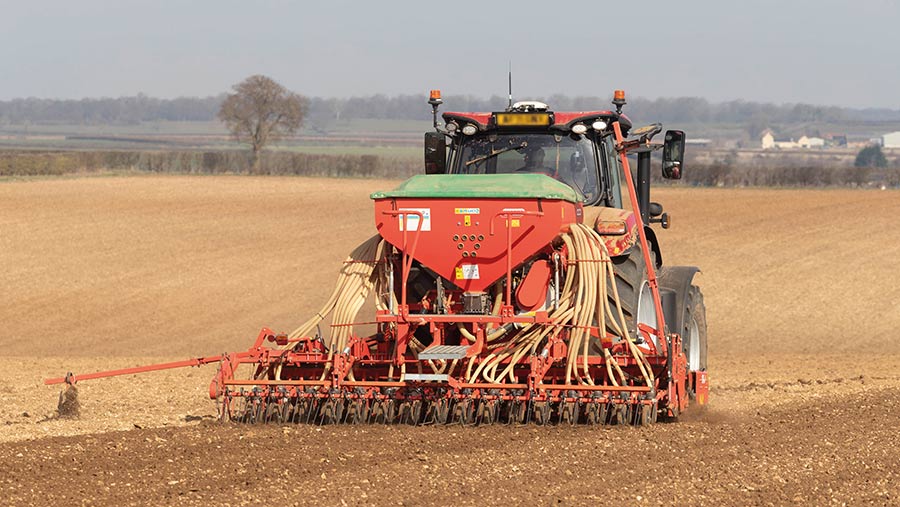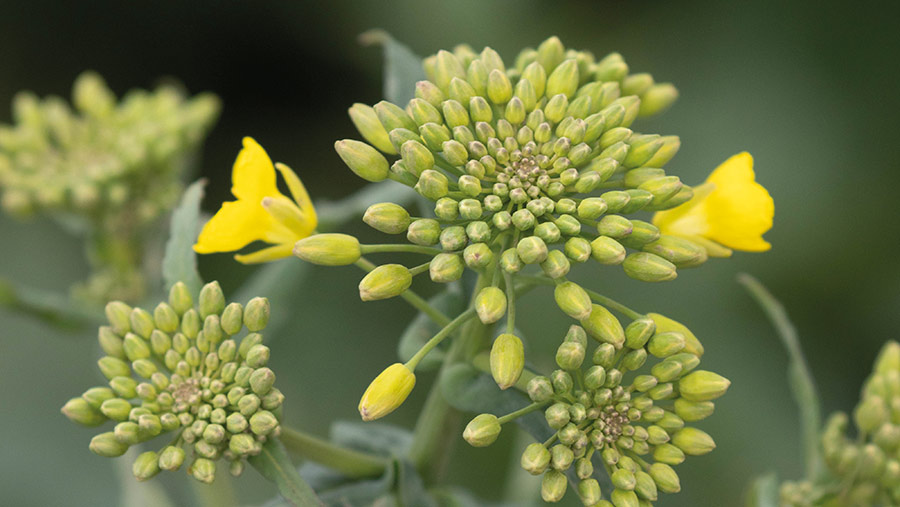Crop Watch: Spring drilling and sulphur fertiliser
 © Tim Scrivener
© Tim Scrivener Daytime temperatures are feeling much more spring-like this week and growers’ drill are out in force.
Wheat crops in the north have begun stem extension and the volatility in markets is making it difficult to plan ahead.
A lot more straight N fertiliser is ending up on farm this year and growers are advised not to forget sulphur, to maximise returns from expensive N fertiliser.
See also: Why forage peas earned a place in Norfolk grower’s rotation
North
David Martindale
Arable Alliance (Yorkshire)
Autumn-sown crops have benefited from a relatively mild and dry winter and appear in good condition.
It is refreshing to see such a large area looking so well compared with the previous two years, where parts of fields had failed, could not get sown or suffered severe waterlogging.
The extreme volatility in commodity and input prices is making it difficult to plan ahead with any degree of certainty.
Hopefully, markets will soon settle down, otherwise growing crops is going to be more risky than going to the casino.
To the here and now, then. Winter wheat crops have begun stem extension and are approaching the T0 timing.
Yellow rust has begun to appear in susceptible varieties and azole fungicides such as tebuconazole will be required to keep the disease under control.
Plant growth regulators (PGRs) will be used at robust rates on earlier-sown crops where fertility is high.
For most situations herbicides for broad-leaved weed control will not be required at this timing, as the autumn control programmes have worked well.
In terms of grassweeds, blackgrass control has been very good where pre-emergence and early post-emergence herbicides were applied on time.
Spring-germinating wild oats are emerging and will be controlled in the coming weeks.
Greening up
Winter barley crops are beginning to green up now due to improved growing conditions and the uptake of the first dose of nitrogen fertiliser.
Disease levels are higher than average, with net blotch and brown rust particularly common along with some mildew.
Earlier-sown crops have begun stem extension and will receive their T1 fungicides shortly.
Winter rye is just beginning to go through its rapid phase of growth. It is phenomenal how quickly it moves through growth stages and builds biomass.
Robust PGR mixes will be applied at growth stage 30-31 and nitrogen rates managed cautiously, as rye is very efficient at scavenging for nutrients.
Again the mild winter has allowed brown rust to develop along with mildew so a fungicide may be added to the PGR mix.
Winter oilseed rape crops mostly look well, with the earlier sown crops having huge canopies.
For these crops the first nitrogen dose has been delayed and the total doses are going to be significantly lower than average, which will prove a useful saving.
PGRs have been applied to crops with a high green area index to reduce lodging risk.
Crops that have suffered severe pigeon grazing are beginning to show signs of recovery, although in the worst cases the final yield potential will be closer to that of a spring-sown crop.
Light leaf spot has gradually been creeping into crops in the past few weeks. Despite the initial lesions looking insignificant, if left uncontrolled the yield loss to light leaf spot can be high.
Fungicides have been applied for its control with the aim of limiting its spread further up the canopy.
Spring drilling is well under way and so far seed-beds have mostly been good, with seeds sown into moisture which should result in even establishment.
For spring beans, look out for signs of pea and bean weevil damage as plants emerge, while for spring malting barley crops aim to complete nitrogen fertiliser applications by the time the crop has reached the three-leaf stage.
East
Ben Pledger
Farmacy (Bedfordshire/Hertfordshire)
I’m writing this looking out at a heavy frost. Temperatures are forecast to reach 16C today.
With warm daytime temperatures such as this, it often feels like it is perfect weather to apply grassweed herbicides such as iodosulfuron + mesosulfuron in winter wheat.
However, high daily temperature fluctuations like this, coupled with herbicide applications, induce crop stress, with symptoms such as yellowing and yield loss.
Crop nutrition and the end goal for the crop is a frequently discussed subject on farm at the moment, mainly down to the price of fertiliser and the added complexities of a lot more straight nitrogen ending up on farm this year, as well as the question of how to deal with the sulphur requirement of the crop.
The action of nitrogen and sulphur in the plant are symbiotic, and to conveniently forget about sulphur applications this year will make sure that the plant doesn’t get the best out of the nitrogen (a reduced amount in many cases) applied to the crop.
Sulphur options
There are a number of ways of getting the sulphur requirement into the crop, and this is dependent on the amount that needs to be applied.
Polysulphate and kieserite are two options I’m using, to be applied as an extra fertiliser pass.
However, sulphate-based foliar nutrition such as manganese sulphate and bittersaltz will be used as well.
With nitrogen being so expensive at the moment, the yield potential for localised areas of crops is being assessed to determine whether the application of nutrition will see a payback in final yield.
Variable-rate nitrogen maps are being used in conjunction with NDVI imagery to reduce rates of fertiliser being applied to poor areas which show little potential in giving a decent yield.
Areas such as wet corners, shaded headlands under woodland, and pest damage will all have their rates cut.
GPS technology, as previously mentioned, isn’t needed to vary the rate across a field, and a lot of this can be done by eye, either varying the forward speed of the applicator, varying the rate manually from within the cab, or shutting the machine off altogether in places.
South
Tod Hunnisett
AICC (Sussex)
Back a few years, when I was younger, fitter, slimmer and richer than I am now, I would escape to somewhere hot for a couple of weeks around the end of February/early March.
Then along came a second raft of university fees, teenage boys with gargantuan appetites and a global curfew, and those days seem a dim and distant memory.
But rarely did I ever come back to find anything had happened on farm.
There is no way I could have taken a fortnight off this year any time after the middle of January.
Along with some benign weather giving farmers twitchy backsides (“Got to get on…”) there has been a constant lurching from one set of impending disasters (nitrogen, glyphosate, spring seed) to the next (“I would get your next five years’ worth of fungicides on farm if I were you,” say the people who know about these things).
If I dare to leave my desk to actually visit a farm, I get back home to a tsunami of deadlines that have been missed “because the prices were pulled this afternoon”.
I know I am not alone with these problems.
OSR
Where I have managed to get out and about, there are some huge variations in what I see. I had three crops of oilseed rape fail this year, all drilled after 21 August.
All the rest, drilled early, look in rude health. It takes a fairly ambitious larva to do any damage to a stem that’s 3cm in diameter.
Early drilled winter wheats on well-drained land look frighteningly forward. They’ll have the book chucked at them this year to get the best out of them.
Mid-drilled wheats (and barleys) on heavy ground look very sad.
I’ve had more winter barley fail this year due to waterlogging than I have had for many years – interesting, in that the total rainfall we’ve had is less than the two winters.
Most things will by now have had a bit of fertiliser. I just hope the tray-tester chaps remembered to empty the tubes back into the bags. Can’t afford to chuck it away…
West
Neil Potts
Matford Arable (Devon)
Where to start, with the brave new world we all find ourselves in?
The economy in general and agriculture in particular are now in what can only be described as an inflationary spiral, but with supply chain issues attached. This will bring challenges to us all as the season progresses.
Leaving these matters aside, crops in general are looking extremely promising as we come out of the winter. More timely plantings and a milder, drier winter than normal have contributed to this.
At the time of writing many crops have received their first top-dressing of nitrogen.
This input of course is much more expensive than in previous years, but there has been a corresponding increase in crop values that mean nitrogen inputs will require minor tweaking rather than wholesale changes to our approach to this input.
Winter barley crops are receiving their T0 applications as I write and the weather is onside, allowing these applications to be applied on time.
Rhynchosporium, mildew and, in pockets, brown rust can all be found in crops that are dense and well developed.
Many winter wheat crops are rapidly approaching GS 30 and will be due to receive their T0 fungicide applications in seven to 14 days’ time.

© Tim Scrivener
Septoria
With many well-tillered and forward crops there is plenty of septoria in the bottom of the crop.
Mild conditions through the winter have allowed septoria to cycle more quickly than might usually be expected, and even varieties with good resistance are manifesting high levels of the disease.
Winter oats are in the same boat as the wheat and barley crops. All crops currently have good levels of Septoria avenae and many crops also have well-established mildew in them.
The OSR crop is on the verge of coming into flower and is looking quite promising at present.
Spring plantings will start in earnest this week (beginning 21 March) as the soil has now dried sufficiently to allow field work without damage being done to soil structure.
As we go forward there are inevitably going to be some supply chain issues due to current global conditions.
However, much has been done to mitigate against these having too much impact on our industry and I would urge everyone not to get involved in panic buying as this will only mean we will end up having issues that wouldn’t have arisen.

